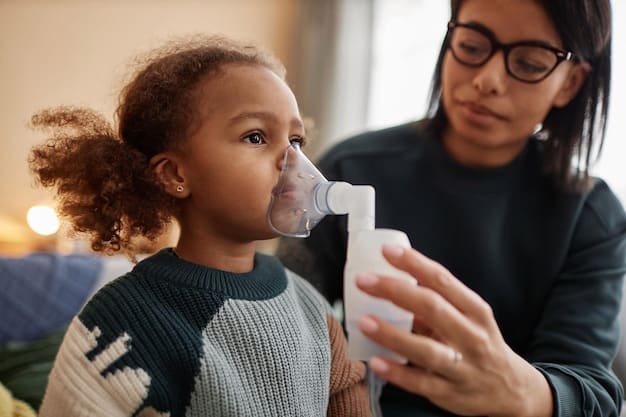Improving Air Quality: US Initiatives for a Healthier 2026

Improving Air Quality: Public Health Initiatives Aiming for a 10% Reduction in Pollution-Related Illnesses by 2026 are crucial for safeguarding public health in the US. These initiatives encompass policy changes, technological advancements, and community engagement to mitigate air pollution and its detrimental health effects.
The air we breathe directly impacts our health, and in the United States, improving air quality: public health initiatives aiming for a 10% reduction in pollution-related illnesses by 2026 is a significant priority. Poor air quality contributes to a range of health problems, from respiratory illnesses to cardiovascular diseases. This article delves into the various public health initiatives underway in the US, all striving towards a common goal: reducing pollution and creating a healthier environment for everyone.
Join us as we explore the innovative strategies, collaborative efforts, and policy advancements that are shaping the future of air quality in the US, and how these efforts aim to make a tangible difference in the lives of millions by 2026.
Understanding the Impact of Air Pollution on Public Health
Air pollution poses a significant threat to public health, contributing to a wide range of illnesses and premature deaths. The consequences of breathing polluted air can be particularly severe for vulnerable populations, including children, the elderly, and individuals with pre-existing respiratory conditions. Recognizing these dangers is a vital first step in addressing the problem and improving air quality: public health initiatives aiming for a 10% reduction in pollution-related illnesses by 2026.
Health Risks Associated with Air Pollution
Exposure to air pollutants can trigger or exacerbate various health issues. Some of the most common health risks include:
- Respiratory illnesses: Asthma, bronchitis, and other respiratory infections are often linked to air pollution.
- Cardiovascular diseases: Heart attacks, strokes, and other cardiovascular problems can be triggered or worsened by exposure to pollutants.
- Cancer: Long-term exposure to certain air pollutants increases the risk of lung cancer and other forms of cancer.
- Developmental problems: Children exposed to air pollution may experience developmental delays and cognitive impairments.
The Economic Burden of Air Pollution
Beyond the direct health impacts, air pollution also imposes a substantial economic burden on society. Healthcare costs, lost productivity, and environmental damage all contribute to the overall economic toll of polluted air. Investing in improving air quality: public health initiatives aiming for a 10% reduction in pollution-related illnesses by 2026 can yield significant economic benefits in the long run as a result.

In conclusion, addressing air pollution is not just a matter of environmental responsibility but also a critical public health imperative. By investing in effective air quality initiatives, we can protect the health of our communities, reduce healthcare costs, and secure a healthier future for generations to come. Improving air quality: public health initiatives aiming for a 10% reduction in pollution-related illnesses by 2026 is achievable through combined efforts.
Key Public Health Initiatives Targeting Air Quality
Several public health initiatives are at the forefront of addressing air pollution in the US. These initiatives encompass a range of strategies, including regulatory measures, technological innovations, and community engagement programs. Understanding these initiatives is essential for appreciating the multifaceted approach required to improving air quality: public health initiatives aiming for a 10% reduction in pollution-related illnesses by 2026.
The Clean Air Act: A Cornerstone of Air Quality Regulation
The Clean Air Act (CAA) is a landmark piece of legislation that has shaped air quality regulation in the US for over five decades. This act establishes air quality standards, regulates emissions from various sources, and empowers states to develop and implement their own air quality management plans. The CAA has been instrumental in improving air quality: public health initiatives aiming for a 10% reduction in pollution-related illnesses by 2026.
Key components of the Clean Air Act include:
- National Ambient Air Quality Standards (NAAQS): These standards set limits on the levels of certain pollutants in the ambient air.
- Permitting programs: These programs regulate emissions from stationary sources, such as power plants and factories.
- Mobile source regulations: These regulations set emission standards for vehicles and other mobile sources.
Investing in Clean Transportation
The transportation sector is a major contributor to air pollution, particularly in urban areas. To mitigate these emissions, various initiatives are promoting cleaner transportation options. Governments are also offering subsidies and incentives for low-emission vehicles, which contributes to improving air quality: public health initiatives aiming for a 10% reduction in pollution-related illnesses by 2026.

Through a combination of regulatory measures, technological advancements, and community engagement, these public health initiatives are paving the way towards cleaner air and a healthier future for all Americans. Improving air quality: public health initiatives aiming for a 10% reduction in pollution-related illnesses by 2026 requires continuous effort.
Technological Innovations Driving Air Quality Improvement
Technological advancements play a crucial role in improving air quality: public health initiatives aiming for a 10% reduction in pollution-related illnesses by 2026. From advanced monitoring systems to innovative emission control technologies, these innovations are enabling us to better understand and mitigate air pollution.
Advanced Air Quality Monitoring Systems
Real-time air quality monitoring is essential for tracking pollution levels, identifying pollution sources, and assessing the effectiveness of air quality interventions. Advanced monitoring systems utilize a variety of sensors and technologies to measure pollutant concentrations in the air.
Key features of advanced air quality monitoring systems include:
- High-resolution sensors: These sensors can detect even trace amounts of pollutants.
- Real-time data transmission: Data is transmitted wirelessly to central databases for analysis and dissemination.
- Cloud-based data analytics: Cloud-based platforms enable sophisticated data analysis and visualization.
Emission Control Technologies in Industries
Industries are a significant source of air pollution, and innovative emission control technologies are helping to reduce these emissions. These technologies can capture pollutants before they are released into the atmosphere, preventing them from contributing to air pollution. One aspect of improving air quality: public health initiatives aiming for a 10% reduction in pollution-related illnesses by 2026 is cleaner industries.
In short, technological innovations are essential tools in our efforts to combat air pollution and protect public health. By embracing these advancements, we can accelerate progress towards improving air quality: public health initiatives aiming for a 10% reduction in pollution-related illnesses by 2026 and ensuring cleaner air for future generations.
Community Engagement and Public Awareness Campaigns
Community engagement and public awareness campaigns are vital components of improving air quality: public health initiatives aiming for a 10% reduction in pollution-related illnesses by 2026 in US. Educating the public about the causes and consequences of air pollution, and empowering communities to take action, can lead to significant improvements in air quality.
The Role of Education in Promoting Clean Air
Education plays a crucial role in fostering a culture of environmental responsibility. By raising awareness about air pollution among children, students, and the general public, we can inspire individuals to adopt behaviors that protect air quality. This includes using public transport and understanding improving air quality: public health initiatives aiming for a 10% reduction in pollution-related illnesses by 2026.
Educational initiatives may include:
- Curriculum integration: Incorporating air quality topics into school curricula.
- Public workshops and seminars: Offering educational programs for the general public.
- Online resources: Providing accessible information about air pollution and clean air practices.
Empowering Communities to Take Action
Engaging communities in air quality monitoring, clean-up efforts, and advocacy can create a sense of shared responsibility and empower residents to take ownership of their environment. Community-based initiatives can also help to identify and address local sources of pollution. This is contributing to improving air quality: public health initiatives aiming for a 10% reduction in pollution-related illnesses by 2026.
In conclusion, community engagement and public awareness campaigns are essential for creating a society that values clean air and actively works to protect it. By educating the public, empowering communities, and fostering collaboration, we can accelerate progress towards improving air quality: public health initiatives aiming for a 10% reduction in pollution-related illnesses by 2026.
Policy Recommendations for Achieving the 2026 Goal
Achieving the ambitious goal of improving air quality: public health initiatives aiming for a 10% reduction in pollution-related illnesses by 2026 requires a combination of effective policies at the local, state, and federal levels. These policies should address a range of issues, from emissions standards to transportation planning, and should be informed by the best available scientific evidence.
Strengthening Emissions Standards
Stricter emissions standards for vehicles, industries, and other sources of air pollution are essential for reducing overall pollution levels. These standards should be regularly updated to reflect technological advancements and evolving scientific understanding. This promotes improving air quality: public health initiatives aiming for a 10% reduction in pollution-related illnesses by 2026 by reducing pollution emissions.
Promoting Sustainable Transportation
Policies that encourage the use of public transportation, walking, and cycling can significantly reduce air pollution from the transportation sector. Investing in infrastructure for these modes of transportation, such as bike lanes and pedestrian-friendly streets, can make them more accessible and attractive. Policies that promote sustainable transport are beneficial for improving air quality: public health initiatives aiming for a 10% reduction in pollution-related illnesses by 2026.
In conclusion, achieving the 2026 goal of reducing pollution-related illnesses requires a comprehensive and coordinated policy approach. By strengthening emissions standards, promoting sustainable transportation, and investing in renewable energy, we can create a cleaner, healthier, and more sustainable future for all.
Measuring Progress and Ensuring Accountability
Measuring progress and ensuring accountability are essential for guiding and evaluating improving air quality: public health initiatives aiming for a 10% reduction in pollution-related illnesses by 2026. Regular monitoring of air quality indicators, transparent reporting of progress, and independent audits can help us stay on track and ensure that resources are being used effectively.
Key Air Quality Indicators
To track progress towards the 2026 goal, it is important to monitor key air quality indicators, such as:
- Particulate matter (PM2.5 and PM10) concentrations: These are measures of the amount of fine and coarse particles in the air and improving air quality: public health initiatives aiming for a 10% reduction in pollution-related illnesses by 2026 will reduce these concentrations.
- Ozone levels: Ozone is a major component of smog and can cause respiratory problems.
- Nitrogen dioxide (NO2) concentrations: NO2 is a pollutant emitted by vehicles and power plants.
Air quality should continue to improve as a result of improving air quality: public health initiatives aiming for a 10% reduction in pollution-related illnesses by 2026.
Independent Audits and Evaluations
Independent audits and evaluations can provide an objective assessment of the effectiveness of air quality initiatives. These audits can identify areas where progress is lagging and recommend improvements to program design and implementation. The audits can assess how improving air quality: public health initiatives aiming for a 10% reduction in pollution-related illnesses by 2026 is proceeding.
In closing, measuring progress and ensuring accountability are essential for achieving the 2026 goal of reducing pollution-related illnesses. By monitoring key air quality indicators, promoting transparent reporting, and conducting independent audits, we can ensure that our efforts are effective and that we are making meaningful progress towards cleaner air and a healthier future.
| Key Point | Brief Description |
|---|---|
| 💨 Reducing Pollution | Initiatives must significantly reduce pollution to improve air quality. |
| 🩺 Healthier US | Aiming for a healthier population by 2026 through clean air efforts. |
| 📊 Measuring Progress | Key indicators will track the reduction in pollution-related illnesses. |
| 🤝 Community Action | Engaging communities in cleanup and awareness campaigns is essential. |
Frequently Asked Questions
The goal is a 10% reduction in illnesses linked to pollution by 2026, through effective public health strategies.
It establishes air quality standards and regulates emissions, crucial for US air quality regulation.
By participating in monitoring, clean-up efforts, and promoting air quality awareness.
Key indicators include reduced particulate matter, ozone, and nitrogen dioxide concentrations.
Stricter emission standards significantly reduce overall pollution levels from various sources.
Conclusion
Improving air quality: public health initiatives aiming for a 10% reduction in pollution-related illnesses by 2026 demands continuous, coordinated efforts. Through vigilant monitoring, robust community engagement, and strategic policy implementations, the US can move closer to this important public health goal.
Let’s amplify these endeavors to safeguard our environment and health, ensuring a sustainable and vibrant future for all citizens in the US.





